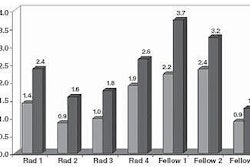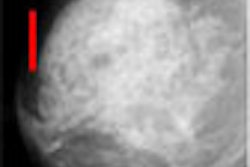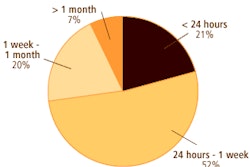Computer-aided detection (CAD) technology can improve breast cancer detection, although it may increase recall rates, according to research published in the October issue of Radiology.
To determine whether CAD could improve the accuracy of single reading of screening mammograms to match that of double reading, a U.K. research team led by Dr. Fiona Gilbert of the University of Aberdeen in Aberdeen, Scotland, retrospectively reviewed a sample of 10,267 mammograms obtained in women age 50 and older who underwent routine screening at one of two breast screening centers in 1996 (Radiology, October 2006, Vol. 241:1, pp. 47-53).
The mammograms, which were double-read in 1996, were randomly reallocated to be read by eight radiologists (who were not recorded as being the first or second radiologist on the initial reading) using CAD (ImageChecker M1000, version 5.0, R2 Technology, Sunnyvale, CA). The anonymized mammograms were digitized and the results of the CAD analysis were displayed on a flat-panel display screen as low-spatial-resolution images displayed with overlaid markers indicating areas of potential abnormalities.
After first viewing the mammogram, the reader recorded any abnormalities, along with a recommendation to either recall the patient for further assessment or ask the patient to return in three years for routine screening. The reader marked the position and type of abnormality on the pro-forma data sheet, scoring the degree of suspicion on a five-point scale.
At that point the reader accessed the prompt image and reviewed the mammograms to further examine any areas with CAD prompts; any additional findings, along with another score and a recommendation for future imaging, were recorded, the researchers stated.
Replacing the 1996 reading procedures, patients were recalled if a score of 3 (indeterminate) or higher was assigned. If a score of 2 (probably benign) was given, the case was discussed with another reader to decide whether to recall the patient.
The researchers compared cancer detection and recall rates from both double reading and single reading with CAD. Single reading with CAD found 49.1% of cancer cases, compared with 42.6% of cancer cases found using double reading. The mean difference in cancer detection rates was 6.5% (p = 0.02), and the lower point of the 95% confidence interval (CI) was 1.1%.
"This indicates that, in terms of sensitivity, the performance of single reading with CAD was better than that of double reading (albeit with a higher recall rate)," the authors wrote.
CAD yielded an overall recall rate of 8.6%, compared with 6.5% for double reading (p < 0.001).
For cancer cases, the two reading techniques had 85% agreement (195 of 230 cases). In cases where there was disagreement, 10 were recalled at double reading but not at single reading with CAD, while 25 were recalled at single reading with CAD but not from double reading.
The recall rate was significantly higher in normal cases for single reading with CAD (7.7% versus 5.7%, p < 0.001), despite the 2% average difference in specificity. For normal cases, the two reading techniques yielded 91% agreement, according to the authors.
For cancers diagnosed between 1996 and 2003, the two techniques had an 84% agreement rate. Single reading with CAD produced a significantly higher cancer detection rate compared with double reading (40% versus 32.7%, p = 0.001).
The researchers acknowledged several limitations in the study, including the sample's makeup of 70% single-view mammograms. Other limitations included the study's retrospective design and the difference in experience levels between the study readers and those participating in the original reading exercise. Also, rereading differed from routine screening in that the readers were aware of the cancer-enriched case mix and that their decisions would not have any clinical implications, according to the researchers.
Nonetheless, the results showed that performance of single reading with CAD is equivalent to that of double reading, the authors concluded.
"There was a slight increase in the recall rate that may have been caused by the additional cancers in the study population," the researchers wrote. "Double reading is the normal practice in the (National Health Service Breast Screening Program); however, it would now be acceptable and ethical to undertake a randomized controlled trial to determine whether diagnostic performance is maintained with CAD in a prospective setting."
By Erik L. Ridley
AuntMinnie.com staff writer
September 29, 2006
Related Reading
Multimodality breast CAD workstation improves diagnostic performance, August 17, 2006
Pilot study: Entropy-driven CAD zips through vast breast image database, August 2, 2006
CAD interval change analysis boosts mammogram accuracy, July 7, 2006
Breast CAD takes aim at architectural distortion, June 30, 2006
Breast CAD put to the test in high-volume community practice, June 26, 2006
Copyright © 2006 AuntMinnie.com



















